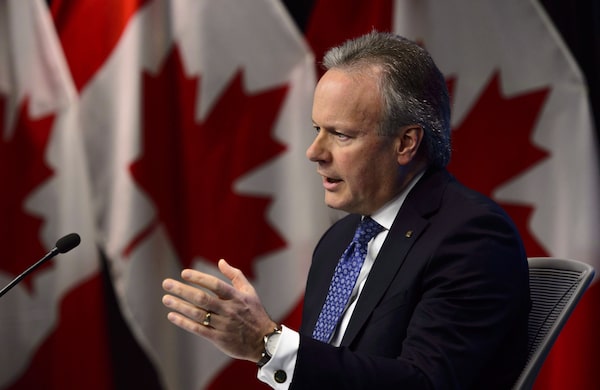
Stephen Poloz, Governor of the Bank of Canada, holds a press conference at the Bank of Canada in Ottawa on Jan. 9, 2019. Mr. Poloz insisted the bank remains committed to getting its benchmark rate, now at 1.75 per cent, back to the estimated neutral range of 2.5 per cent to 3.5 per cent.Sean Kilpatrick/The Canadian Press
Bank of Canada Governor Stephen Poloz is doubling down on his commitment to let the latest economic data determine how and when to restore higher interest rates.
Mr. Poloz acknowledged on Thursday that the central bank, which has kept its key rate on hold since October, is struggling to make sense of two sources of often-conflicting uncertainty buffeting the economy – the cooling housing market and sluggish business investment.
“The path back to that neutral range is highly uncertain,” Mr. Poloz said in a speech to the Chamber of Commerce of Metropolitan Montreal.
“We’re data dependent. So it depends how the economy delivers,” he told reporters after the speech.
Mr. Poloz insisted the bank remains committed to getting its benchmark rate, now at 1.75 per cent, back to the estimated neutral range of 2.5 per cent to 3.5 per cent. The neutral rate is the level at which it neither heats up the economy, nor slows it down.
Mr. Poloz’s tone suggests further rate hikes aren’t likely until late this year, according to analysts. The bank has raised its key rate five times since mid-2017.
“The bank is still leaning toward lifting rates, but not by much not any time soon,” Bank of Montreal economist Sal Guatieri said in a research note.
The central bank may eventually find that the neutral rate may be “a bit below” its current estimate, Toronto-Dominion Bank economist Brian DePratto said. “We may be closer to the destination than previously thought.”
Mr. Poloz offered few new clues about the pace and timing of getting back to neutral in a speech mainly devoted to talking about the limitations of monetary policy.
“In certain circumstances, relying less on low-interest rates to bring the economy home can mean a more resilient economy,” Mr. Poloz pointed out.
And he warned that the performance of the economy since the previous recession is proof that low and stable interest rates aren’t a cure-all.
“We must never lose sight of the fact that there are limitations on the power of monetary policy,” he explained. “We have only one instrument at our disposal. History proves that even a successful monetary policy can generate harmful side effects.”
For example, the bank is closely watching how Canadians are reacting to higher interest rates and tighter mortgage rules, introduced last year. Mr. Poloz said housing resales have been “a little weaker than expected” – an indication there may have been “more froth in certain housing markets than previously thought.”
The cooling housing market has been most evident in Toronto and Vancouver, he said. Gone are the bidding wars and soaring prices.
Historically low interest rates have similarly not been enough to drive business investment in Canada. Mr. Poloz acknowledged that business investment has been “less robust” than expected, largely because of the uncertainty hanging over the future of North American free-trade agreement. He said the bank expects business spending to “regain momentum” this year, aided by new federal tax rules that allow companies to write off their investments more quickly.
But it’s all shrouded with uncertainty because the new U.S.-Mexico-Canada Agreement remains unratified and the United States and China are locked in a high-stakes trade showdown.
“An escalation of the U.S.-led trade war would … be a negative for the outlook, but a resolution would be a new source of lift for the global and Canadian economies,” Mr. Poloz said.
Mr. Poloz said the bank is working to address the limitations of monetary policy as it works towards the renewal in 2021 of its inflation-targeting agreement with the federal government.